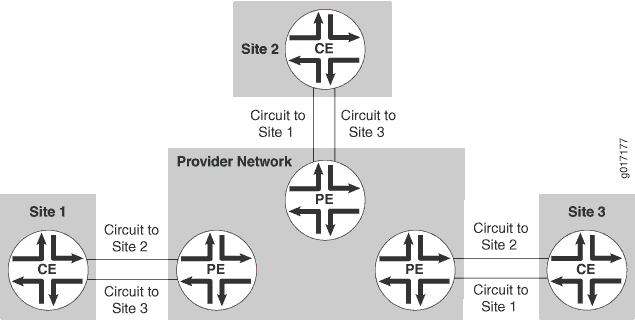Understanding Layer 2 VPNs
As the need to link different Layer 2 services to one another for expanded service offerings grows, Layer 2 Multiprotocol Label Switching (MPLS) VPN services are increasingly in demand.
Implementing a Layer 2 VPN on a router is similar to implementing a VPN using other Layer 2 technologies. However, for a Layer 2 VPN on a router, traffic is forwarded to the router in a Layer 2 format. It is carried by MPLS over the service provider’s network, and then converted back to Layer 2 format at the receiving site. You can configure different Layer 2 formats at the sending and receiving sites. The service provisioned with Layer 2 VPNs is also known as Virtual Private Wire Service (VPWS).
On a Layer 2 VPN, routing occurs on the customer’s routers, typically on the customer edge (CE) router. The CE router connected to a service provider on a Layer 2 VPN must select the appropriate circuit on which to send traffic. The provider edge (PE) router receiving the traffic sends it across the service provider’s network to the PE router connected to the receiving site. The PE routers do not need to store or process the customer’s routes; they only need to be configured to send data to the appropriate tunnel.
For a Layer 2 VPN, customers need to configure their own routers to carry all Layer 3 traffic. The service provider needs to know only how much traffic the Layer 2 VPN will need to carry. The service provider’s routers carry traffic between the customer’s sites using Layer 2 VPN interfaces. The VPN topology is determined by policies configured on the PE routers.
Customers need to know only which VPN interfaces connect to which of their own sites. Figure 1 illustrates a Layer 2 VPN in which each site has a VPN interface linked to each of the other customer sites.

Implementing a Layer 2 MPLS VPN includes the following benefits:
Service providers do not have to invest in separate Layer 2 equipment to provide Layer 2 VPN service. A Layer 2 MPLS VPN allows you to provide Layer 2 VPN service over an existing IP and MPLS backbone.
You can configure the PE router to run any Layer 3 protocol in addition to the Layer 2 protocols.
Customers who prefer to maintain control over most of the administration of their own networks might want Layer 2 VPN connections with their service provider instead of a Layer 3 VPN.
Because Layer 2 VPNs use BGP as the signaling protocol, they have a simpler design and require less overhead than traditional VPNs over Layer 2 circuits. BGP signaling also enables autodiscovery of Layer 2 VPN peers. Layer 2 VPNs are similar to BGP or MPLS VPNs and VPLS in many respects; all three types of services employ BGP for signaling.
